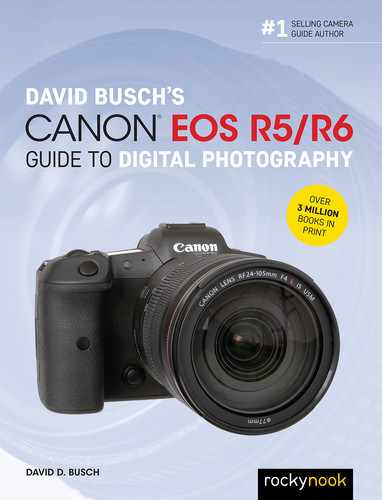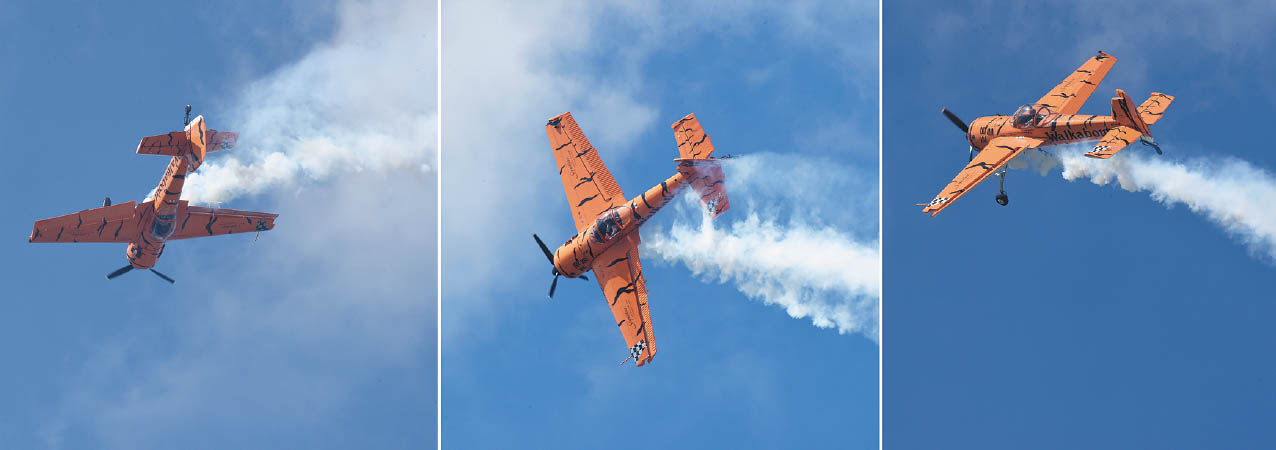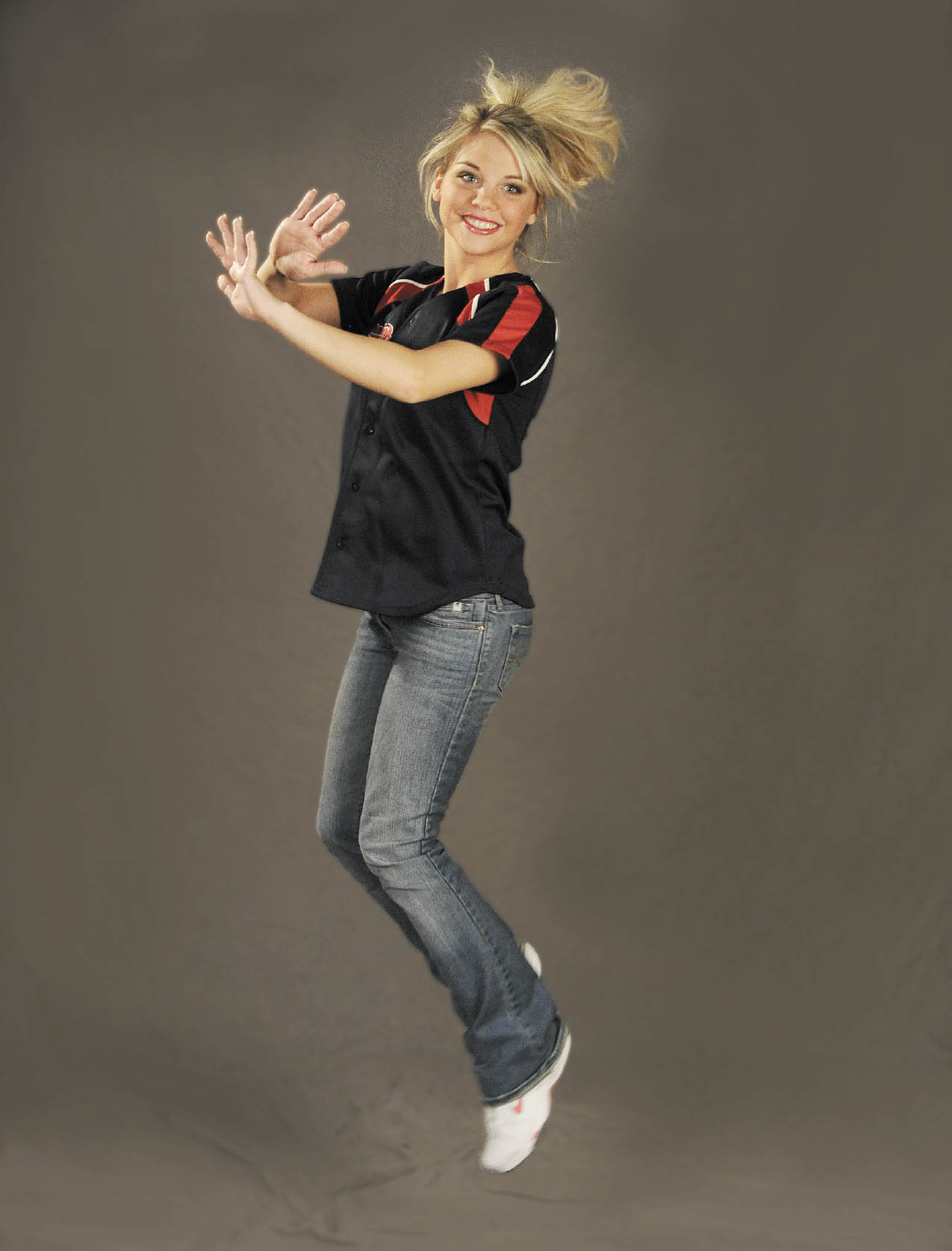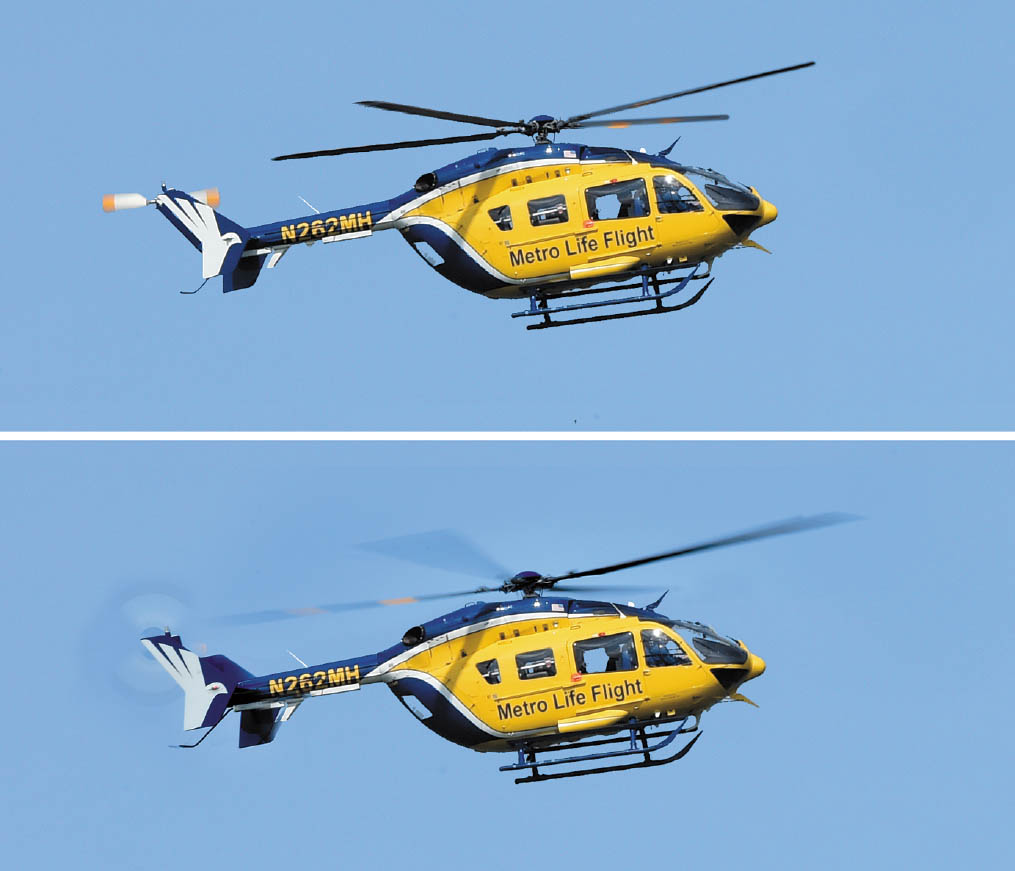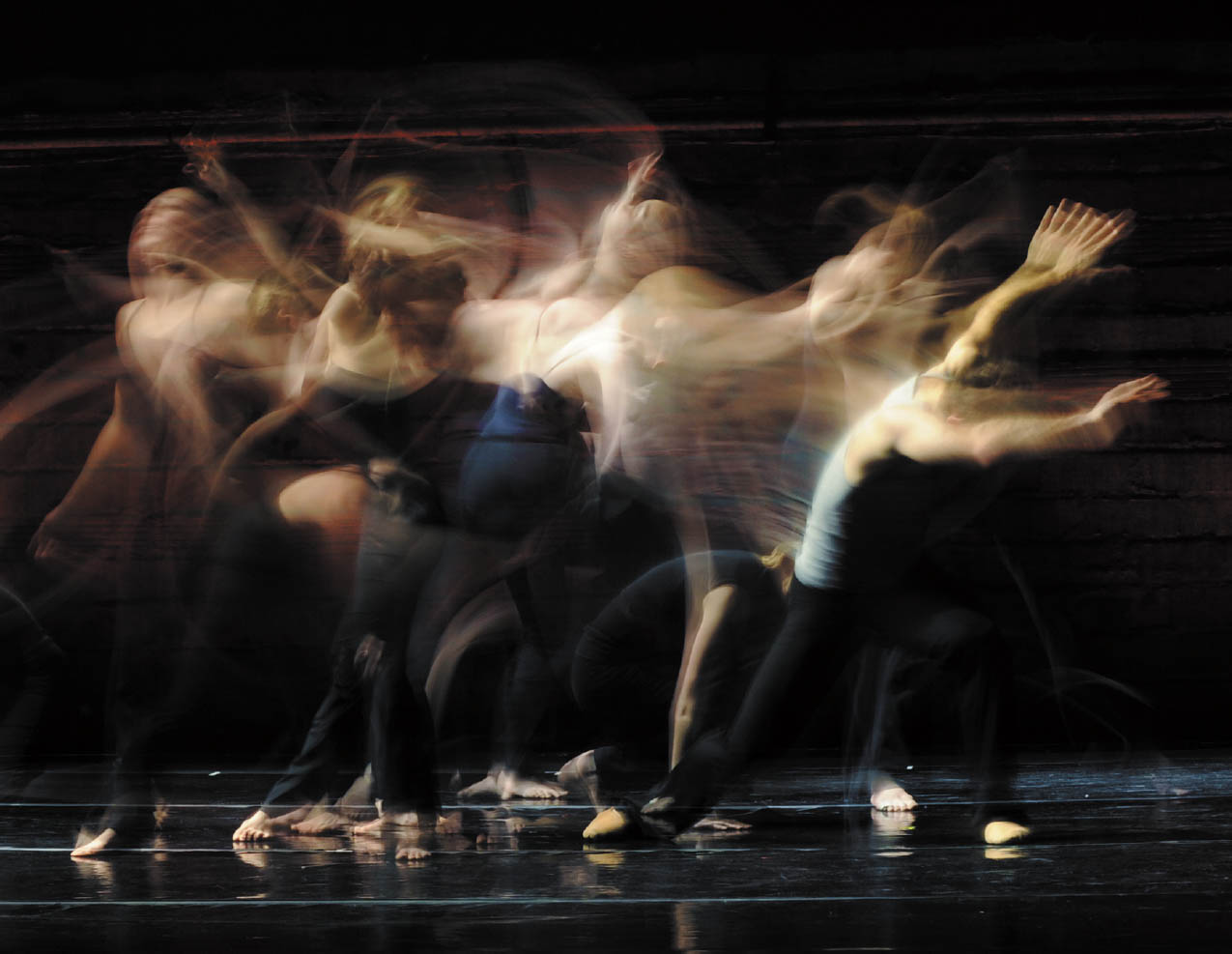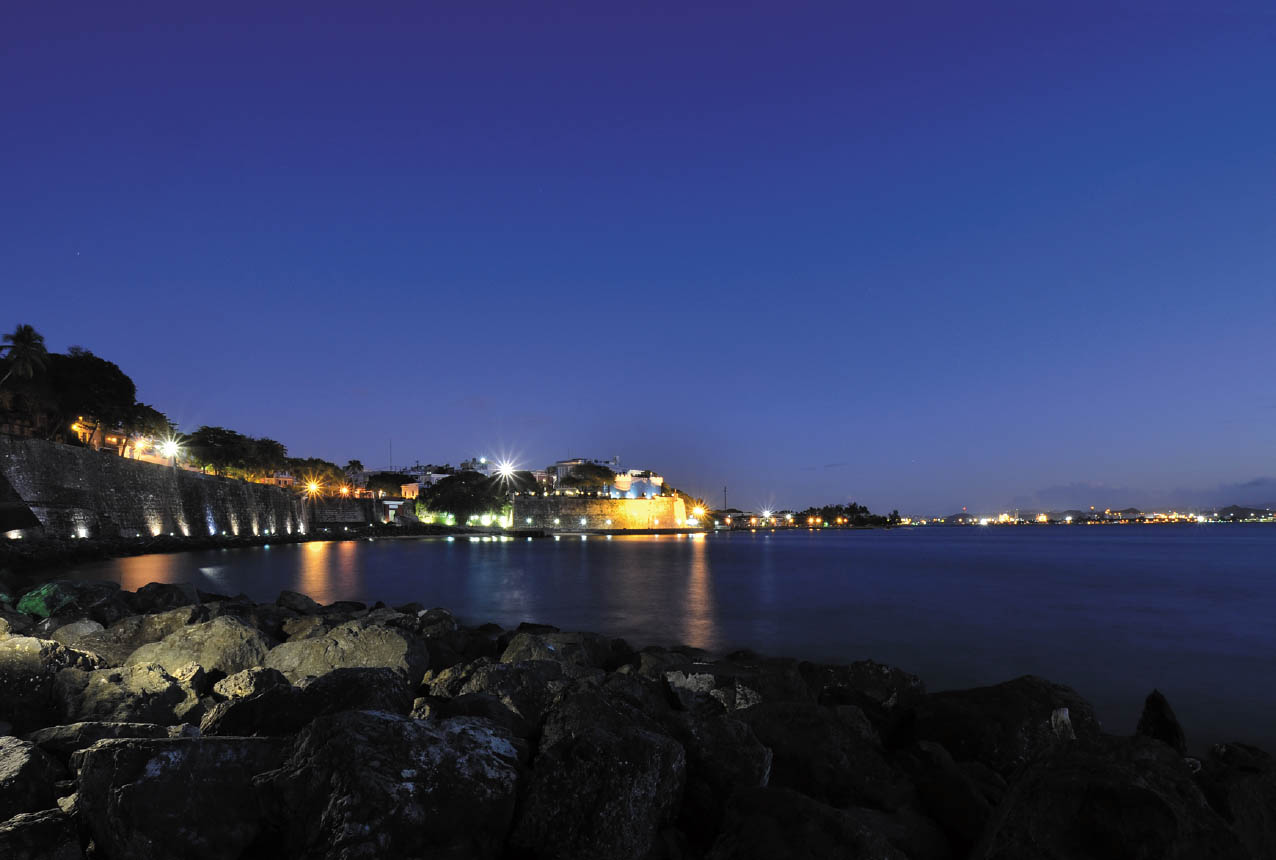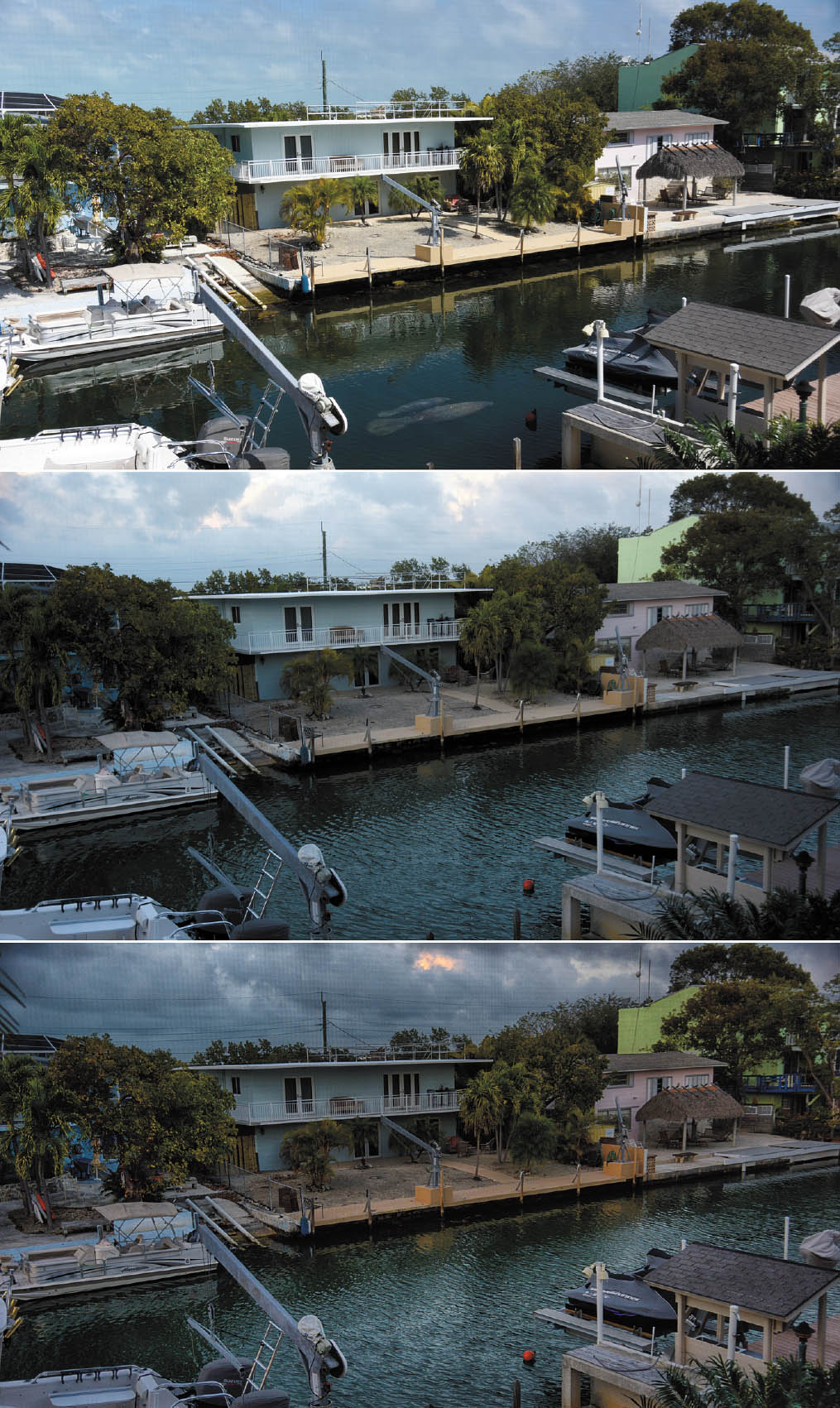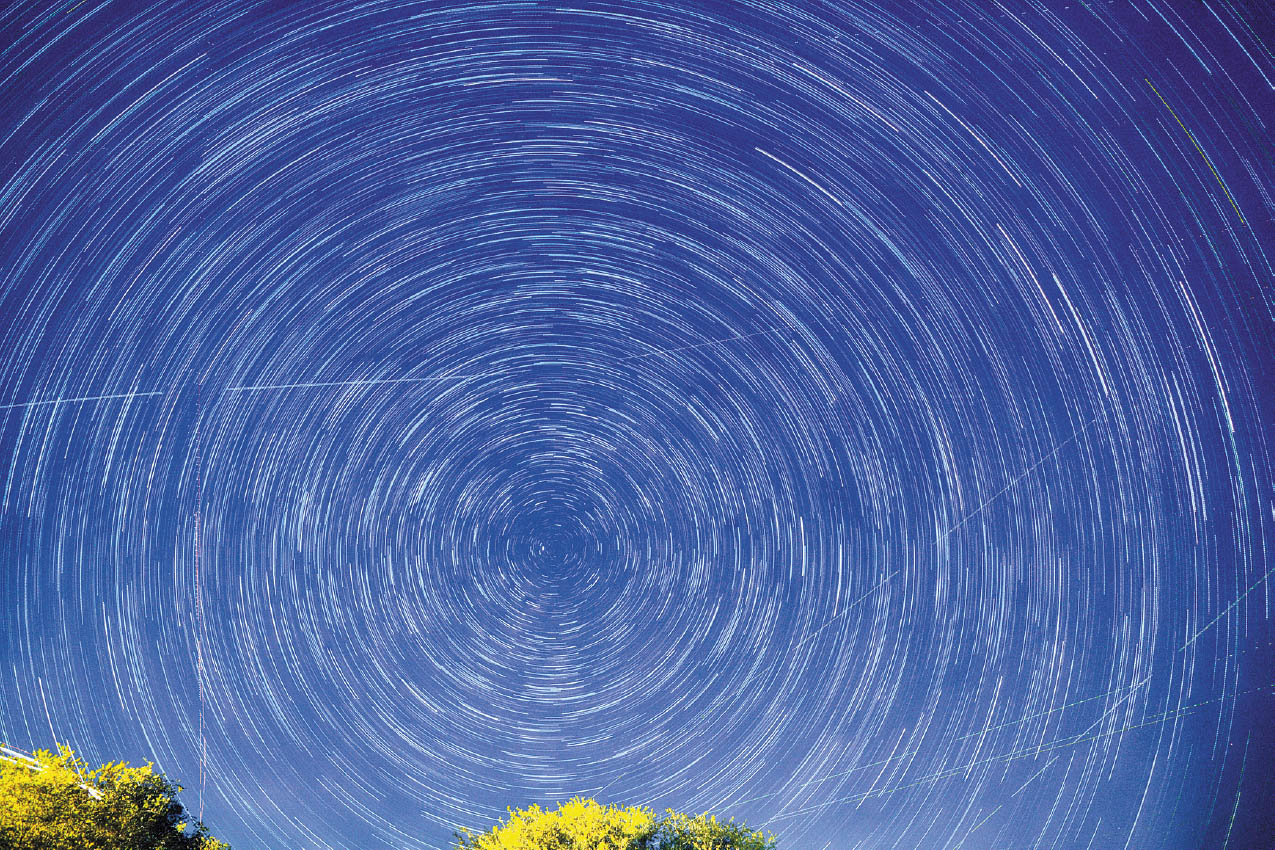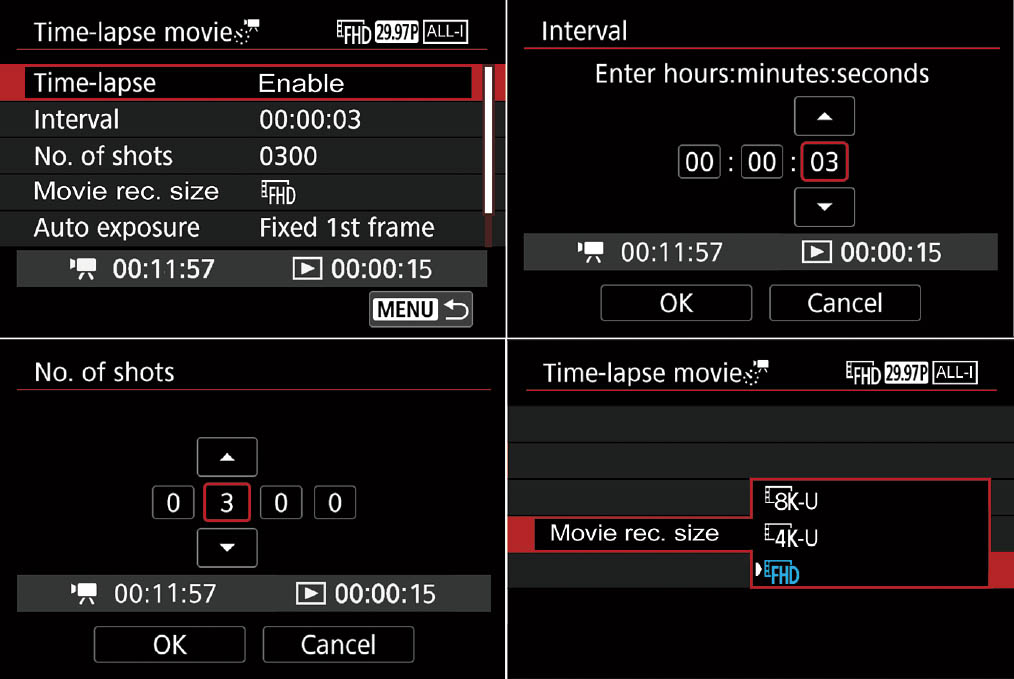6 |
You can happily spend your entire shooting career using the techniques and features already explained in this book. Great exposures, sharp pictures, and creative compositions are all you really need to produce great shot after great shot. But, those with enough interest in getting the most out of their camera who buy this book probably will be interested in going beyond those basics to explore some of the more advanced techniques and capabilities of the camera. Capturing the briefest instant of time and transforming common scenes into the unusual with lengthy time exposures are tempting avenues for exploration. So, in this chapter, I’m going to offer longer discussions of some of the more advanced techniques and capabilities that I like to put to work.
Continuous Shooting
The continuous shooting mode reminds me how far digital photography has brought us. The first accessory I purchased when I worked as a sports photographer many years ago was a motor drive for my film SLR. It enabled me to snap off a series of shots in rapid succession, which came in very handy when a fullback broke through the line and headed for the end zone. Even a seasoned action photographer can miss the decisive instant when a crucial block is made, or a baseball superstar’s bat shatters and pieces of cork fly out. Continuous shooting simplifies taking a series of pictures, either to ensure that one has more or less the exact moment you want to capture or to capture a sequence that is interesting as a collection of successive images. Digital cameras have reusable “film,” so if you waste a few dozen shots on non-decisive moments, you can erase them and shoot more. Save only the best shots, like the series shown in Figure 6.1.
To use the continuous shooting mode, press the Q button and navigate to the Drive icon, which is the fourth from the top in the left column, just under the Image Quality icons. You can also access Drive mode from the M-Fn button’s Dial Functions; press the button and rotate the QCD-1 until Drive mode is highlighted, then rotate the Main Dial to select. In both cases, you can choose from three continuous shooting settings: High-speed continuous + (up to 12 fps), High-speed continuous (up to 6 fps with mechanical shutter and 8 fps with the electronic first-curtain shutter), and Low-speed continuous shooting (approximately 3 fps).
Figure 6.1 Continuous shooting allows you to capture an entire sequence of exciting moments as they unfold.
Actual frames per second in either mode may be reduced when flicker control is enabled, you’re using Dual Pixel RAW (with the R5), you’ve activated Servo AF, or when you’re working with electronic flash. Other factors can come into play when shooting in high-speed mode, which is also affected by many shooting settings, including shutter speed, aperture, autofocus mode, or even the type of lens you are using. (Only certain EF lenses are compatible with the 12 fps rate; Canon lists those lenses on Page 896 of the R5 guide, and Page 851 of the R6 guide.) A cold or nearly dead battery can also reduce shooting speeds.
When you partially depress the shutter button, a number representing the maximum number of shots you can take at the current quality settings is displayed. In the viewfinder, that number is located to the left of the battery status indicator at lower right, immediately above the Possible Shots value. On the LCD screen, the maximum burst is located to the immediate right of the Possible Shots indicator at upper left.
The display shows a maximum of 99 shots remaining; it’s possible that the camera can take more than that, so the 99 will remain lit until the actual number remaining drops below that value. When the internal buffer is full, a “BUSY” indicator will be shown. When the internal buffer fills, the camera will stop capturing images until enough pictures have been written to the memory card to allow shooting to resume. As you might expect, the number of continuous shots you can fire off before that happens varies with the format you choose and the write speed of your card. For that reason, a fast memory card is a good idea. Those who own the EOS R5 will get the best results from their CFexpress cards, which are much faster than even the speediest SDXC media.
The reason the size of your bursts is limited by the buffer is that continuous images are first shuttled into the camera’s internal memory, then doled out to the memory card as quickly as they can be written to the card. Technically, the camera takes the RAW data received from the digital image processor and converts it to the output format you’ve selected—either JPG or RAW/DPRAW, or both—and deposits it in the buffer ready to store on the card.
This internal “smart” buffer can suck up photos much more quickly than the memory card and, indeed, some memory cards are significantly faster or slower than others. Canon estimates that when shooting RAW+JPEG Large, you can get a maximum burst of 79 shots (SDXC card) or 160 shots (CFexpress) with the R5. The R6 should provide roughly the same performance, but with a slightly larger number of shots (91) for SDXC cards.
If you’re capturing just JPEG Large images, the smaller file size of the R6 images pays dividends: Canon estimates that you’d get a maximum burst of about 350 shots with the R5 (for both SDXC and CFexpress media), but you can expect “1,000 or more” (italics, mine) with the R6.
In all cases, you’ll get the best results when using a shutter speed of 1/500th second, the widest opening of the lens, One-Shot autofocus, and when image stabilization is turned off. However, when One-Shot AF is active, the camera will focus only once at the beginning of the sequence, and then use that focus setting for the rest of the shots in the burst. If your subject is moving, you can use Servo AF instead, at a slightly slower continuous frame rate.
Setting High ISO Speed Noise Reduction to High also limits the length of your continuous burst. You’ll also see a decrease if lens aberration correction is active, or you have the camera set to do white balance bracketing. (In such cases, the camera stores multiple copies of each image snapped, slowing down the burst rate.) Anti-flicker shooting and Dual Pixel RAW (with the R5) also reduce the continuous shooting speed. While you can use flash in continuous mode, the camera will wait for the flash to recycle between shots, slowing down the continuous shooting rate.
BURSTS NOT JUST FOR ACTION
I often use continuous shooting mode even when I’m not busy shooting action. As I’ve mentioned before, bursts make sense when you’re shooting HDR or bracketing. But here’s a technique you might not have thought of—continuous shooting can give you sharper images!
When I’m photographing concerts, I enjoy greater mobility by not using a monopod (and a tripod would be even more of a ball-and-chain, even if not forbidden by the venue). I’m generally shooting at around 1/180th second, which is usually fast enough to eliminate blur from the performers’ motion. IS has no effect on stopping their movement, of course, and it does a fairly good job of eliminating camera/photographer shake. However, I invariably find that if I shoot in continuous, one of the middle frames in a sequence will be sharpest. Even the most seasoned photographer will add a little bump to the camera when they squeeze (not stab) the shutter release.
More Exposure Options
In Chapter 4, you learned techniques for getting the right exposure, but I haven’t explained all your exposure options just yet. You’ll want to know about the kind of exposure settings that are available to you. There are options that let you control when the exposure is made, or even how to make an exposure that’s out of the ordinary in terms of length (time or bulb exposures). The sections that follow explain your camera’s special exposure features, and even discuss a few it does not have (and why it doesn’t).
A Tiny Slice of Time
Exposures that seem impossibly brief can reveal a world we didn’t know existed. In the 1930s, Dr. Harold Edgerton, a professor of electrical engineering at MIT, pioneered high-speed photography using a repeating electronic flash unit he patented called the stroboscope. As the inventor of the electronic flash, he popularized its use to freeze objects in motion, and you’ve probably seen his photographs of bullets piercing balloons and drops of milk forming a coronet-shaped splash.
Electronic flash freezes action by virtue of its extremely short duration—as brief as 1/50,000th second or less. You can read more about using electronic flash to stop action in Chapter 9.
Of course, the camera is fully capable of immobilizing all but the fastest movement using only its shutter speeds, which range all the way up to 1/8000th second. Indeed, you’ll rarely have need for such a brief shutter speed in ordinary shooting. If you wanted to use an aperture of f/2.8 at ISO 100 outdoors in bright sunlight, for some reason, a shutter speed of 1/8000th second would more than do the job. You’d need a faster shutter speed only if you moved the ISO setting to a higher sensitivity (but why would you do that?). Under less than full sunlight, 1/8000th second is more than fast enough for any conditions you’re likely to encounter.
Most sports action can be frozen at 1/2000th second or slower, and for many sports a slower shutter speed is actually preferable—for example, to allow the wheels of a racing automobile or motorcycle, or the propeller on a classic aircraft to blur realistically.
But if you want to do some exotic action-freezing photography without resorting to electronic flash, the top shutter speed is at your disposal. Here are some things to think about when exploring this type of high-speed photography:
- You’ll need a lot of light. High shutter speeds cut very fine slices of time and sharply reduce the amount of illumination that reaches your sensor. To use 1/4000th second at an aperture of f/6.3, you’d need an ISO setting of 800—even in full daylight. To use an f/stop smaller than f/6.3 or an ISO setting lower than 800, you’d need more light than full daylight provides. (That’s why electronic flash units work so well for high-speed photography when used as the sole illumination; they provide both the effect of a brief shutter speed and the high levels of illumination needed.)
- Don’t combine high shutter speeds with electronic flash. You might be tempted to use an electronic flash with a high shutter speed. Perhaps you want to stop some action in daylight with a brief shutter speed and use electronic flash only as supplemental illumination to fill in the shadows. Unfortunately, under most conditions you can’t use flash in subdued illumination at any shutter speed faster than 1/200th second. That’s the fastest speed at which the camera’s focal plane shutter is fully open: at shorter speeds, a “slit” comes into play, so that the flash will expose only the small portion of the sensor exposed by the slit during its duration. (Check out “Avoiding Sync Speed Problems” in Chapter 9 if you want to see how you can use shutter speeds shorter than 1/200th second with certain Canon Speedlites, albeit at much-reduced effective power levels.)
Working with Short Exposures
You can have a lot of fun exploring the kinds of pictures you can take using very brief exposure times, whether you decide to take advantage of the action-stopping capabilities of your external electronic flash or work with the faster shutter speeds. Here are a few ideas to get you started:
- Take revealing images. Fast shutter speeds can help you reveal the real subject behind the façade, by freezing constant motion to capture an enlightening moment in time. Legendary fashion/portrait photographer Philippe Halsman used leaping photos of famous people, such as the Duke and Duchess of Windsor, Richard Nixon, and Salvador Dali to illuminate their real selves. Halsman said, “When you ask a person to jump, his attention is mostly directed toward the act of jumping and the mask falls so that the real person appears.” Try some high-speed portraits of people you know in motion to see how they appear when concentrating on something other than the portrait. (See Figure 6.2.)
- Create unreal images. High-speed photography can also produce photographs that show your subjects in ways that are quite unreal. A helicopter in mid-air with its rotors frozen makes for an unusual picture. Figure 6.3 shows a pair of pictures. At top, a shutter speed of 1/1000th second virtually stopped the rotation of the chopper’s rotors, while the bottom image, shot at 1/200th second, provides a more realistic view of the blurry blades as they appeared to the eye.
- Capture unseen perspectives. Some things are never seen in real life, except when viewed in a stop-action photograph. Edgerton’s balloon bursts were only a starting point. Freeze a hummingbird in flight for a view of wings that never seem to stop. Or, capture the splashes as liquid falls into a bowl, as shown in Figure 6.4. No electronic flash was required for this image (and wouldn’t have illuminated the water in the bowl as evenly). Instead, a clutch of high-intensity lamps and an ISO setting of 1600 allowed the camera to capture this image at 1/2000th second.
- Vanquish camera shake and gain new angles. Here’s an idea I mentioned earlier in this chapter that’s so obvious it isn’t always explored to its fullest extent. A high enough shutter speed can free you from the tyranny of a tripod, making it easier to capture new angles, or to shoot quickly while moving around, especially with longer lenses. I tend to use a monopod or tripod for almost everything when I’m not using an image-stabilized lens, and I end up missing some shots because of a reluctance to adjust my camera support to get a higher, lower, or different angle. If you have enough light and can use an f/stop wide enough to permit a high shutter speed, you’ll find a new freedom to choose your shots. I have a favored 500mm lens that I use for sports and wildlife photography, almost invariably with a tripod, as I don’t find the “reciprocal of the focal length” rule particularly helpful in most cases. (I would not hand-hold this hefty lens with a 1/500th second shutter speed under most circumstances.) However, at 1/2000th second or faster, and with a sufficiently high ISO setting (I recommend ISO 800–1600) to allow such a speed, it’s entirely possible for a steady hand to use this lens without a tripod or monopod’s extra support, and I’ve found that my whole approach to shooting animals and other elusive subjects changes in high-speed mode.
Figure 6.2 When your subjects leap, the real person inside emerges.
Figure 6.3 Top: the chopper’s blades are frozen at 1/1000th second; bottom: a more realistic blurry rendition at 1/200th-second shutter speed.
Figure 6.4 A large amount of artificial illumination and an ISO 1600 sensitivity setting allowed capturing this shot at 1/2000th second without use of an electronic flash.
Long Exposures
Longer exposures are a doorway into another world, showing us how even familiar scenes can look much different when photographed over periods measured in seconds. At night, long exposures produce streaks of light from moving, illuminated subjects like automobiles or amusement park rides. Extra-long exposures of seemingly pitch-dark subjects can reveal interesting views using light levels barely bright enough to see by. At any time of day, including daytime (in which case you’ll often need the help of neutral-density filters, which reduce the amount of light passing through the lens, to make the long exposure practical), long exposures can cause moving objects to vanish entirely, because they don’t remain stationary long enough to register in a photograph.
Three Ways to Take Long Exposures
There are actually three common types of lengthy exposures: timed exposures, bulb exposures, and time exposures. Your camera offers all three. Because of the length of the exposure, all of the following techniques should be used with a tripod to hold the camera steady.
- Timed exposures. These are long exposures from 1 second to 30 seconds, measured by the camera itself. To take a picture in this range, simply use Manual or Tv modes and use the Main Dial to set the shutter speed to the length of time you want, choosing from preset speeds of 1.0, 1.5, 2.0, 3.0, 4.0, 6.0, 8.0, 10.0, 15.0, 20.0, or 30.0 seconds (if you’ve specified 1/2-stop increments for exposure adjustments), or 1.0, 1.3, 1.6, 2.0, 2.5, 3.2, 4.0, 5.0, 6.0, 8.0, 10.0, 13.0, 15.0, 20.0, 25.0, and 30.0 seconds (if you’re using 1/3-stop increments). The advantage of timed exposures is that the camera does all the calculating for you. There’s no need for a stopwatch. If you review your image on the LCD and decide to try again with the exposure doubled or halved, you can dial in the correct exposure with precision. The disadvantage of timed exposures is that you can’t take a photo for longer than 30 seconds.
- Bulb exposures. This type of exposure is so-called because in the olden days the photographer squeezed and held an air bulb attached to a tube that provided the force necessary to keep the shutter open. Traditionally, a bulb exposure is one that lasts as long as the shutter release button is pressed; when you release the button, the exposure ends. To make a bulb exposure, set the mode to B. Then, press the shutter to start the exposure, and press it again to close the shutter. The disadvantages of this mode are exposures must be timed manually, and with shorter exposures, it’s possible for the vibration of manually opening and closing the shutter to register in the photo. For longer exposures, the period of vibration is relatively brief and not usually a problem—and there is always the release cable option to eliminate photographer-caused camera shake entirely.
- Time exposures. This is a setting found on some cameras to produce longer exposures. It’s actually an enhancement of the Bulb exposure feature. With the camera’s mode set to Bulb, locate the Bulb Timer setting in the Shooting 6 menu. Press SET, and in the screen that pops up, highlight Enable. Press the INFO button, and a screen appears that will allow you to set an exposure time of up to 99 hours, 59 minutes, and 59 seconds. You’ll rarely need extra-long exposures (unless you’re shooting continuous star trails), but many exposures longer than 30 seconds are quite useful. For example, many star photographers shoot multiple one-minute exposures (any longer than that, and the star pinpoints become blurs) and then merge them together to get a different kind of sky photograph.
Working with Long Exposures
Because your camera can produce such good images at longer exposures, and there are so many creative things you can do with long-exposure techniques, you’ll want to do some experimenting. Get yourself a tripod or another firm support and take some test shots with long exposure noise reduction both enabled and disabled using the entry in the Shooting 4 menu, as explained in Chapter 11 (to see whether you prefer low noise or high detail) and get started. Here are some things to try:
- Make people invisible. One very cool thing about long exposures is that objects that move rapidly enough won’t register at all in a photograph, while the subjects that remain stationary are portrayed in the normal way. That makes it easy to produce people-free landscape photos and architectural photos at night or, even, in full daylight if you use a neutral-density filter (or two or three) to allow an exposure of at least a few seconds. At ISO 100, f/22, and a pair of 8X (three-stop) neutral-density filters, you can use exposures of nearly two seconds; overcast days and/or more neutral-density filtration would work even better if daylight people-vanishing is your goal. They’ll have to be walking very briskly and across the field of view (rather than directly toward the camera) for this to work. At night, it’s much easier to achieve this effect with the 20-to 30-second exposures that are possible, as you can see in Figure 6.5.
Figure 6.5 This alleyway is thronged with people, as you can see in this two-second exposure using only the available illumination (left). With the camera still on a tripod, a 30-second exposure rendered the passersby almost invisible (right).
- Create streaks. If you aren’t shooting for total invisibility, long exposures with the camera on a tripod or monopod can produce some interesting streaky effects, as you can see in Figure 6.6. You don’t need to limit yourself to indoor photography, however. Even a single 8X ND filter will let you shoot at f/22 and 1/6th second in full daylight at ISO 100.
- Produce light trails. At night, car headlights and taillights and other moving sources of illumination can generate interesting light trails. Your camera doesn’t even need to be mounted on a tripod; hand-holding for longer exposures adds movement and patterns to your trails. If you’re shooting fireworks (preferably with a tripod), a longer exposure of several seconds may allow you to combine several bursts into one picture. Or, you can record the movement of a Ferris wheel, as shown in Figure 6.7.
Figure 6.6 These dancers produced a swirl of movement during the 1/8th-second exposure.
Figure 6.7 A long exposure of several seconds allows capturing the movement of this Ferris wheel.
- Blur waterfalls, etc. You’ll find that waterfalls and other sources of moving liquid produce a special type of long exposure blur, because the water merges into a fantasy-like veil that looks different at different exposure times, and with different waterfalls. Cascades with turbulent flow produce a rougher look at a given longer exposure than falls that flow smoothly. Although blurred waterfalls have become almost a cliché, there are still plenty of variations for a creative photographer to explore, as you can see in Figure 6.8.
- Show total darkness in new ways. Even on the darkest nights, there is enough starlight or glow from distant illumination sources to see by, and, if you use a long exposure, there is enough light to take a picture, too. Figure 6.9 shows San Juan, Puerto Rico late at night.
Figure 6.8 A 1/4-second exposure blurred the falling water.
Figure 6.9 A 20-second exposure revealed this view of San Juan, Puerto Rico.
Delayed Exposures
Sometimes it’s desirable to have a delay of some sort before a picture is actually taken. Perhaps you’d like to get in the picture yourself and would appreciate it if the camera waited 10 seconds after you press the shutter release to actually take the picture. Maybe you want to give a tripod-mounted camera time to settle down and damp any residual vibration after the release is pressed to improve sharpness for an exposure with a relatively slow shutter speed. It’s possible you want to explore the world of time-lapse photography. The next sections present your delayed exposure options.
Self-Timer
The built-in self-timer has 10-second and 2-second delays. Activate the timer using the Drive option in the Q menu, QCD-1 to select the drive modes. Press the shutter release button halfway to lock in focus on your subjects (if you’re taking a self-portrait, focus on an object at a similar distance and use focus lock). When you’re ready to take the photo, continue pressing the shutter release the rest of the way. The lamp on the front of the camera will blink slowly for eight seconds (when using the 10-second timer) and the beeper will chirp (if you haven’t disabled it in the Shooting menu, as described in Chapter 11). During the final two seconds, the beeper sounds more rapidly, and the lamp remains on until the picture is taken. The top-panel LCD displays a countdown while all this is going on.
This is something you might want to do if you’re shooting close-ups, landscapes, or other types of pictures using the self-timer, to trip the shutter in the most vibration-free way possible. Forget to bring along your tripod, but still want to take a close-up picture with a precise focus setting? Set your digital camera to the self-timer function, then put the camera on any reasonably steady support, such as a fence post or a rock. When you’re ready to take the picture, press the shutter release. The camera might teeter back and forth for a second or two, but it will settle back to its original position before the self-timer activates the shutter. The self-timer remains active until you turn it off—even if you power down your camera—so remember to turn it off when finished.
Time Lapse and Interval Photography
Who hasn’t marveled at interval stills, shot moments or minutes apart to document an event, or wasn’t enrapt by a time-lapse movie of a flower opening, a series of shots of the moon marching across the sky, or one of those extreme interval or time-lapse photography productions showing something that takes a very, very long time, such as a building under construction.
You probably won’t be shooting such construction shots, unless you have a spare camera you don’t need for a few months (or are willing to go through the rigmarole of figuring out how to set up your camera in precisely the same position using the same lens settings to shoot a series of pictures at intervals). However, other kinds of time-lapse photography are entirely within reach.
For Figure 6.10, I pointed my camera out my office window in Florida, hoping to use Interval Timing Shooting to catch some manatees. I left the camera running for hours, capturing the three images shown in the figure. I’ve also used interval shooting for HDR images of sunsets. Typically, I aim the camera at the horizon and set it to shoot a three-shot bracket with a 3.0-stop increment. Then, I set the interval time to capture an image every 10 seconds.
Figure 6.10 One of my time-lapse photos captured a mother manatee and her calf swimming by (top); the other exposures produced interesting variations on a static scene.
The built-in features allow you to shoot interval sequences and time-lapse movies easily. Before I explain how to use these features, here are a few things to keep in mind:
- Use AC power. If you’re shooting a long sequence, consider connecting your camera to an AC adapter, as leaving the camera on for long periods of time will rapidly deplete the battery. The optional Canon DC Coupler DR-E6 and AC Adapter AC-6N are perfect for this application. While shooting time-lapse movies, auto power off will not take place.
- Disabled functions. While capturing time-lapse movies, shooting and menu functions and playback are disabled, and output to HDMI (both monitor and recorder) is disabled. You can’t shoot time-lapse movies if digital zoom is enabled, and sound and time codes are not recorded. Auto-focus is disabled during time-lapse recording (to avoid focus changing between shots). When using Movie Tv mode with the R5, the aperture is fixed and exposure is adjusted by changing the ISO, again, to avoid focus/depth-of-field changes.
- Make sure you have enough storage space. Unless your memory card has enough capacity to hold all the images you’ll be taking, you might want to change to a reduced resolution to maximize the image count. With a 256GB memory card, you should be able to record an 8K time-lapse movie (R5 only) up to 26 minutes long before the card fills. At 4K and FHD, that same card will accommodate a 72 minute recording at 4K, and 6 hours, 19 minutes at FHD with both the R5 and R6.
- Protect your camera. If your camera will be set up for an extended period of time (longer than an hour or two), make sure it’s protected from weather, earthquakes, animals, young children, innocent bystanders, and theft.
- Vary intervals. Experiment with different time intervals. You don’t want to take pictures or frames too often or less often than necessary to capture the changes you hope to image in your movies or still series. If a scheduled shot is not possible (say, the time required to write to the card exceeds the shooting interval), it will be skipped.
Using Interval Photography
This next section will tell you everything you need to know to capture images using the camera’s built-in intervalometer. To set up interval timer shooting, just follow these steps.
- 1. Access feature. Choose Interval Timer from the Shooting 6 menu. The screen shown in Figure 6.11 appears.
- 2. Activate Interval timer. Highlight Enable and press SET. The Adjust Interval/Shots screen pops up.
- 3. Choose interval. Highlight Interval and chose the elapsed time between exposures, up to 99 hours, 59 minutes, and 59 seconds. The interval cannot be shorter than the shutter speed; for example, you cannot set one second as the interval if the images will be taken at two seconds or longer. If the camera is unable to take a scheduled image because it is busy doing something else (for example, saving the last exposure), the shot will be skipped.
Figure 6.11 Interval timer shooting options.
- 4. Select Number of Shots. You can choose the number of individual shots that will be taken, from 1 to 99. Photography will stop when the specified number of exposures are captured. If you want the camera to continue shooting until you stop it (or the memory card fills, or your camera is stolen), enter 00.
- 5. Confirm. Highlight OK. The interval and number of shots will be displayed in the Shooting 6 menu. You can calculate the total time elapsed by multiplying the interval times the number of shots. For example, with the maximum elapsed time of almost 100 hours, it will take more than 400 days to shoot 99 individual exposures. In practice, your sequence should be a bit shorter than that.
- 6. Start sequence. Press the shutter release all the way to begin capturing your interval sequence.
Here are some additional tips for interval shooting:
- Extra shots. Even while interval shooting is underway you can take a picture by pressing the shutter release. You can even change shooting settings, access menus, and playback images, except for the last five seconds before the next scheduled interval shot is taken.
- Shooting flexibility. You can activate Auto Exposure or White Balance Bracketing, specify Multiple Exposures, or shoot HDR images during interval shooting. Instructions for these features are found in Chapter 11.
- Saving power. The camera automatically powers down after eight seconds but will wake up again about one minute before the next scheduled shot. You can keep the camera “awake” by setting Auto Power Off under the Power Saving entry in the Set-up 2 menu to Disable.
Star Trails
Star trails are another great application for both long exposures and interval shooting. You can shoot the night sky using long exposures with your camera mounted on a tripod. However, because of the rotation of the Earth, longer exposures will record the apparent motion of the celestial objects through the sky, producing a light trail. If you use a very, very long exposure, the light trail will record as continuous streaks, centered around the Polaris (the North Star) in the northern hemisphere and Sigma Octantis (which is, unfortunately, too dim to be easily seen with the naked eye) in the southern hemisphere. If you activate Extended Shutter Speeds, you can record night shots as long as 15 minutes.
Such long exposures can result in excessive noise and sensor overheating, so it’s more common for photographers to take a series of individual exposures and combine them to produce a single star trail image. If you want your stars to appear as reasonably sharp points, you’ll need to keep the exposure short enough that their movement in the sky isn’t apparent. Fortunately, there’s a simple formula you can use to calculate that exposure time, the “500 Rule.” Divide 500 by the focal length of your lens to determine the longest exposure (in seconds) before stars start to produce a blurred trail. For example, with a 50mm lens, the longest exposure would be 10 seconds (500 divided by 50). Capturing the complete canopy of stars generally requires a wider viewing perspective. With the 16mm wide-angle setting, exposures could be as long as roughly 30 seconds.
For Figure 6.12, I set my camera to ISO 200, and used a basic exposure of 30 seconds at f/5.6. I selected an interval of 32 seconds and 170 total exposures, which totals about 90 minutes. Noise reduction was OFF! Then, I followed these steps, using Photoshop:
- 1. Transfer files to a folder. Select a folder on your computer and copy all your files to that location.
- 2. In Photoshop: Choose Files > Scripts > Load Files into Stack.
- 3. Browse to folder. Click the Browse button and navigate to the folder where your images are stored.
- 4. Click OK. Photoshop will create a file with one layer for each of your captured images.
- 5. Select All layers. Then click Layer Blending Options from the Layers palette and choose Lighten.
- 6. Flatten image. You’ll want to flatten your image (the multi-layer file will be huge!). You’ll end up with an impressive star trail image.
Time-lapse Movies
The time-lapse movie facility is actually a still photography mode that shoots images at intervals you specify, and then stitches them together automatically to create an MP4-format movie in Full HD (1920 × 1080) and 4K formats (3840 × 2160) at a playback rate of 30/25 fps (NTSC/PAL). The R5 can also capture 8K time-lapse movies.
Figure 6.12 Capturing a star trail.
To create a time-lapse movie, just follow these steps:
- 1. Switch to Movie mode. Using the MODE button (R5) or Mode Dial (R6), switch to a movie mode. Even though time-lapse clips are a series of stills, you must be in Movie mode to access the feature. Even though individual images are still photographs, no stills are stored; they are converted to a movie file even if you take only one shot in time-lapse mode.
- 2. Navigate to the Movie Shooting 5 menu. Select Time-Lapse Movie and press SET.
- 3. Choose Enable. Highlight Time-lapse Movie and press SET. Choose Enable (see Figure 6.13 top left).
- 4. Specify interval and number of shots. The options shown in Figure 6.13 top right and bottom left, appear in the main Time-lapse menu. You can choose the interval between shots, from 2 seconds up to 99 hours, 59 minutes, and 59 seconds, and the total number of shots (from 2 to 3600) to take in the sequence. The expected elapsed time for the entire sequence is shown near the bottom of the screen.
- 5. Choose Movie Recording Size. The screen for the R5 is shown in Figure 6.13, lower right, with choices 8K-U, 4K-U, and FHD. The R6 screen is similar but has only 4K and FHD options.
- 6. Select Exposure Setting. Highlight Auto Exposure and press SET. You can then choose:
- • Fixed 1st Frame. Metering takes place and the exposure is set for the first frame and used for all subsequent frames. You’d use this setting when you want the exposure to remain constant, even if lighting changes.
- • Each frame. Metering is performed for each shot in the sequence. A time-lapse movie of a city skyline from dawn to dusk will reflect the correct exposure for each stage of the day.
Figure 6.13 Enable/disable and check settings on this screen.
- 7. Screen Auto Off. Choose this setting to specify whether you want each captured image to be displayed.
- • Disable. The sensor image will be displayed at all times during capture, except during the moment of exposure. The screen will eventually turn off roughly 30 minutes after shooting started.
- • Enable. The screen turns off 10 seconds after shooting begins. This gives you a chance to monitor the first shot, so you’ll know the scene is framed and exposed as you intend.
- 8. Specify beeper. You’ll need to scroll down to see this option. After setting Screen Auto Off, you can enable or disable the Beep As Image Taken feature to provide feedback that the sequence is still underway. Because the electronic shutter is used, there is no other indicator that an exposure has been made.
- 9. Confirm. When finished setting each parameter, highlight OK and press SET to confirm.
- 10. Exit menu and test settings. Press MENU to exit the menu system. A message appears on the LCD monitor advising you to make your exposure settings and press the shutter release to take a test shot. Note that you can use a range of shutter speeds from 1/4000th to 30 seconds (in Movie Manual exposure mode on the R6 or Tv and Manual mode on the R5). If you’ve selected a speed slower than 1/60th second, when capture ends the camera will change to a shutter speed allowable for movie shooting.
- 11. Exit setup. When satisfied with your exposure settings, press OK to exit the set-up screen.
- 12. Take test shot. Press the shutter button (not Movie button) to take a test shot, which will be created as a JPEG Large image.
- 13. Start time-lapse. When ready to begin, press the Movie button to commence your time-lapse movie. You can cancel by pressing the shutter button completely or Movie button.
- 14. Turn on screen (optional). You can check your settings by pressing the INFO button to turn the screen on or off.
- 15. Stop capture. While the time-lapse movie is recording, you can return to the Time-lapse menu setting and switch to Disable. When time-lapse shooting ends, the settings are cleared, and the camera resumes normal Movie shooting mode.
